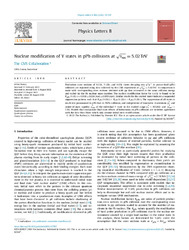Nuclear modification of Y states in pPb collisions at √sNN = 5.02 TeV
| dc.contributor.author | Tumasyan, A. | |
| dc.contributor.author | Işıldak, Bora | |
| dc.date.accessioned | 2023-09-13T08:44:03Z | |
| dc.date.available | 2023-09-13T08:44:03Z | |
| dc.date.issued | 2022-12-10 | |
| dc.identifier.issn | 0370-2693 | en_US |
| dc.identifier.uri | http://hdl.handle.net/10679/8812 | |
| dc.identifier.uri | https://www.sciencedirect.com/science/article/pii/S0370269322005317 | |
| dc.description.abstract | Production cross sections of [Formula presented], [Formula presented], and [Formula presented] states decaying into [Formula presented] in proton-lead (pPb) collisions are reported using data collected by the CMS experiment at sNN=5.02TeV. A comparison is made with corresponding cross sections obtained with pp data measured at the same collision energy and scaled by the Pb nucleus mass number. The nuclear modification factor for [Formula presented] is found to be [Formula presented]. Similar results for the excited states indicate a sequential suppression pattern, such that [Formula presented]. The suppression of all states is much less pronounced in pPb than in PbPb collisions, and independent of transverse momentum [Formula presented] and center-of-mass rapidity [Formula presented] of the individual [Formula presented] state in the studied range [Formula presented] and [Formula presented]. Models that incorporate final-state effects of bottomonia in pPb collisions are in better agreement with the data than those which only assume initial-state modifications. | en_US |
| dc.description.sponsorship | BMBWF and FWF (Austria); FNRS and FWO (Belgium); CNPq, CAPES, FAPERJ, FAPERGS, and FAPESP (Brazil); MES and BNSF (Bulgaria); CERN; CAS, MOST, and NSFC (China); MINCIENCIAS (Colombia); MSES and CSF (Croatia); RIF (Cyprus); SENESCYT (Ecuador); MoER, ERC PUT and ERDF (Estonia); Academy of Finland, MEC, and HIP (Finland); CEA and CNRS/IN2P3 (France); BMBF, DFG, and HGF (Germany); GSRI (Greece); NKFIA (Hungary); DAE and DST (India); IPM (Iran); SFI (Ireland); INFN (Italy); MSIP and NRF (Republic of Korea); MES (Latvia); LAS (Lithuania); MOE and UM (Malaysia); BUAP, CINVESTAV, CONACYT, LNS, SEP, and UASLP-FAI (Mexico); MOS (Montenegro); MBIE (New Zealand); PAEC (Pakistan); MSHE and NSC (Poland); FCT (Portugal); JINR (Dubna); MON, ROSATOM, RAS, RFBR, and NRC KI (Russia); MESTD (Serbia); MCIN/AEI and PCTI (Spain); MoSTR(Sri Lanka); Swiss Funding Agencies (Switzerland); MST (Taipei); ThEPCenter, IPST, STAR, and NSTDA (Thailand); TUBITAK and TAEK (Turkey); NASU (Ukraine); STFC (United Kingdom); DOE and NSF (USA). Individuals have received support from the Marie-Curie program and the European Research Council and Horizon 2020 Grant, contract Nos. 675440, 724704, 752730, 758316, 765710, 824093, 884104, and COST Action CA16108 (European Union); the Leventis Foundation; the Alfred P. Sloan Foundation; the Alexander von Humboldt Foundation; the Belgian Federal Science Policy Office; the Fonds pour la Formation a la Recherche dans l'Industrie et dans l'Agriculture (FRIA-Belgium); the Agentschap voor Innovatie door Wetenschap en Technologie (IWT-Belgium); the F.R.S.-FNRS and FWO (Belgium) under the "Excellence of Science -EOS" -be.h project n. 30820817; the Beijing Municipal Science & Technology Commission, No. Z191100007219010; The Ministry of Education, Youth and Sports(MEYS) of the Czech Republic; the Deutsche Forschungsgemeinschaft (DFG), under Germany's Excellence Strategy -EXC 2121 "Quantum Universe" -390833306, and under project number 400140256 -GRK2497; the Lendulet ("Momentum") Program and the Janos Bolyai Research Scholarship of the Hungarian Academy of Sciences, the New National Excellence Program UNKP, the NKFIA research grants 123842, 123959, 124845, 124850, 125105, 128713, 128786, and 129058 (Hungary); the Council of Science and Industrial Research, India; the Latvian Council of Science; the Ministry of Science and Higher Education and the National Science Center, contracts Opus 2014/15/B/ST2/03998 and 2015/19/B/ST2/02861 (Poland); the Fundacao para a Ciencia e a Tecnologia, grant CEECIND/01334/2018 (Portugal); the National Priorities Research Program by Qatar National Research Fund; the Ministry of Science and Higher Education, projects no. 0723-2020-0041 and no. FSWW-2020-0008 (Russia); MCIN/AEI/10. 13039/501100011033, ERDF "a way of making Europe", and the Programa Estatal de Fomento de la Investigacion Cientifica y Tecnica de Excelencia Maria de Maeztu, grant MDM-2017-0765 and Programa Severo Ochoa del Principado de Asturias (Spain); the Stavros Niarchos Foundation (Greece); the Rachadapisek Sompot Fund for Postdoctoral Fellowship, Chulalongkorn University and the Chulalongkorn Academic into Its 2nd Century Project Advancement Project (Thailand); the Kavli Foundation; the Nvidia Corporation; the SuperMicro Corporation; the Welch Foundation, contract C-1845; and the Weston Havens Foundation (USA). | |
| dc.language.iso | eng | en_US |
| dc.publisher | Elsevier | en_US |
| dc.relation.ispartof | Physics Letters B | |
| dc.rights | Attribution 4.0 International | * |
| dc.rights | openAccess | |
| dc.rights.uri | http://creativecommons.org/licenses/by/4.0/ | * |
| dc.title | Nuclear modification of Y states in pPb collisions at √sNN = 5.02 TeV | en_US |
| dc.type | Article | en_US |
| dc.description.version | Publisher version | en_US |
| dc.peerreviewed | yes | en_US |
| dc.publicationstatus | Published | en_US |
| dc.contributor.department | Özyeğin University | |
| dc.contributor.authorID | (ORCID 0000-0002-0283-5234 & YÖK ID 124605) Işıldak, Bora | |
| dc.contributor.ozuauthor | Işıldak, Bora | |
| dc.creator | The CMS Collaboration | |
| dc.identifier.volume | 835 | en_US |
| dc.identifier.wos | WOS:000912783600001 | |
| dc.identifier.doi | 10.1016/j.physletb.2022.137397 | en_US |
| dc.subject.keywords | Bottomonium | en_US |
| dc.subject.keywords | CMS | en_US |
| dc.subject.keywords | Heavy ion collisions | en_US |
| dc.subject.keywords | Quark-gluon plasma | en_US |
| dc.subject.keywords | Quarkonium suppression | en_US |
| dc.identifier.scopus | SCOPUS:2-s2.0-85139112681 | |
| dc.relation.publicationcategory | Article - International Refereed Journal - Institutional Academic Staff |
Files in this item
This item appears in the following Collection(s)
Share this page




